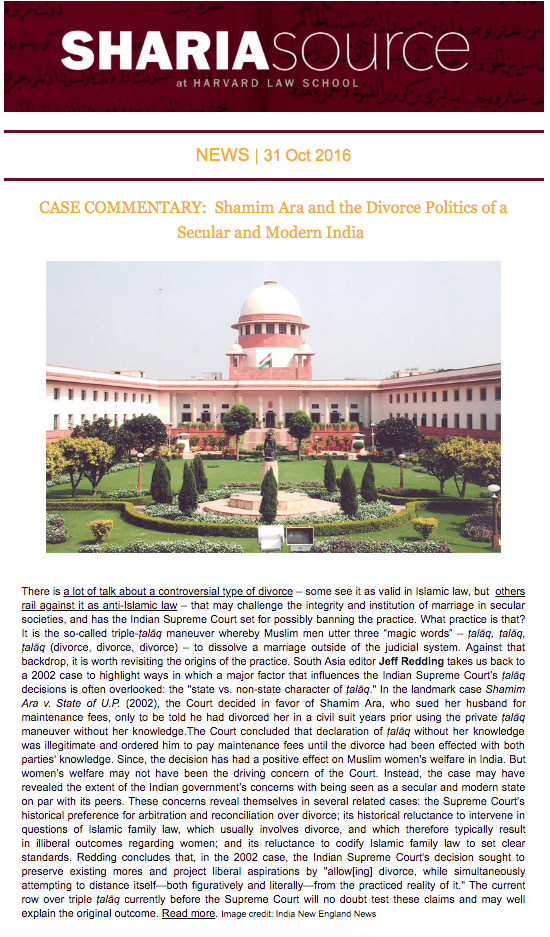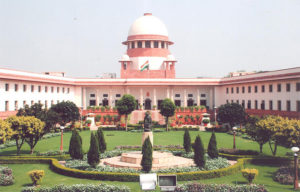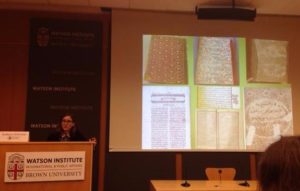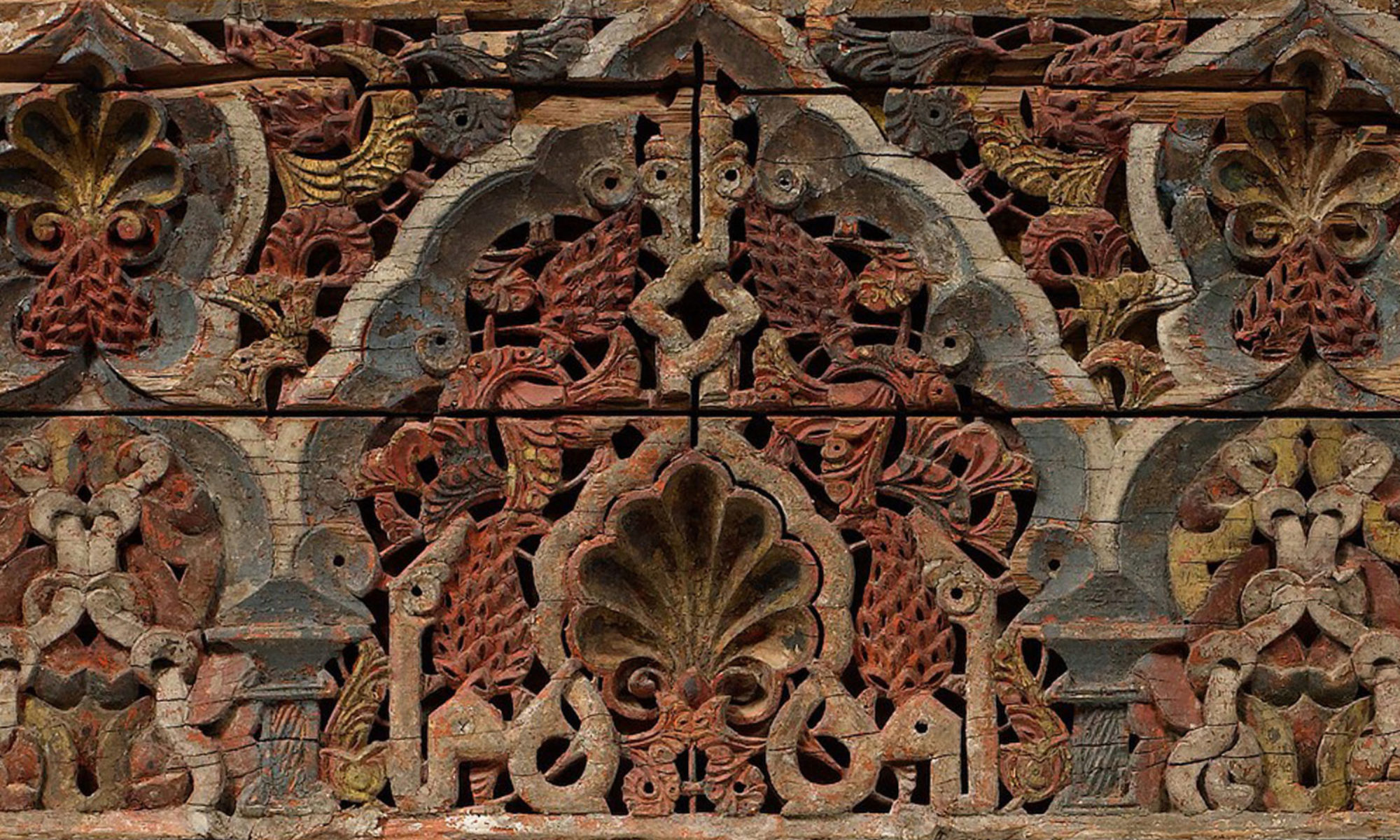
 CASE COMMENTARY: Shamim Ara and the Divorce Politics of a Secular and Modern India There is a lot of talk about a controversial type of divorce – some see it as valid in Islamic law, but others rail against it as anti-Islamic law – that may challenge the integrity and institution of marriage in secular societies, and has the Indian Supreme Court set for possibly banning the practice. What practice is that? It is the so-called triple-ṭalāq maneuver whereby Muslim men utter three “magic words” – ṭalāq, ṭalāq, ṭalāq (divorce, divorce, divorce) – to dissolve a marriage outside of the judicial system. Against that backdrop, it is worth revisiting the origins of the practice. South Asia editor Jeff Redding takes us back to a 2002 case to highlight ways in which a major factor that influences the Indian Supreme Court’s ṭalāq decisions is often overlooked: the “state vs. non-state character of ṭalāq.” In the landmark case Shamim Ara v. State of U.P. (2002), the Court decided in favor of Shamim Ara, who sued her husband for maintenance fees, only to be told he had divorced her in a civil suit years prior using the private ṭalāq maneuver without her knowledge.The Court concluded that declaration of ṭalāq without her knowledge was illegitimate and ordered him to pay maintenance fees until the divorce had been effected with both parties’ knowledge. Since, the decision has had a positive effect on Muslim women’s welfare in India. But women’s welfare may not have been the driving concern of the Court. Instead, the case may have revealed the extent of the Indian government’s concerns with being seen as a secular and modern state on par with its peers. These concerns reveal themselves in several related cases: the Supreme Court’s historical preference for arbitration and reconciliation over divorce; its historical reluctance to intervene in questions of Islamic family law, which usually involves divorce, and which therefore typically result in illiberal outcomes regarding women; and its reluctance to codify Islamic family law to set clear standards. Redding concludes that, in the 2002 case, the Indian Supreme Court’s decision sought to preserve existing mores and project liberal aspirations by “allow[ing] divorce, while simultaneously attempting to distance itself—both figuratively and literally—from the practiced reality of it.” The current row over triple ṭalāq currently before the Supreme Court will no doubt test these claims and may well explain the original outcome. Read more. Image credit: India New England News
CASE COMMENTARY: Shamim Ara and the Divorce Politics of a Secular and Modern India There is a lot of talk about a controversial type of divorce – some see it as valid in Islamic law, but others rail against it as anti-Islamic law – that may challenge the integrity and institution of marriage in secular societies, and has the Indian Supreme Court set for possibly banning the practice. What practice is that? It is the so-called triple-ṭalāq maneuver whereby Muslim men utter three “magic words” – ṭalāq, ṭalāq, ṭalāq (divorce, divorce, divorce) – to dissolve a marriage outside of the judicial system. Against that backdrop, it is worth revisiting the origins of the practice. South Asia editor Jeff Redding takes us back to a 2002 case to highlight ways in which a major factor that influences the Indian Supreme Court’s ṭalāq decisions is often overlooked: the “state vs. non-state character of ṭalāq.” In the landmark case Shamim Ara v. State of U.P. (2002), the Court decided in favor of Shamim Ara, who sued her husband for maintenance fees, only to be told he had divorced her in a civil suit years prior using the private ṭalāq maneuver without her knowledge.The Court concluded that declaration of ṭalāq without her knowledge was illegitimate and ordered him to pay maintenance fees until the divorce had been effected with both parties’ knowledge. Since, the decision has had a positive effect on Muslim women’s welfare in India. But women’s welfare may not have been the driving concern of the Court. Instead, the case may have revealed the extent of the Indian government’s concerns with being seen as a secular and modern state on par with its peers. These concerns reveal themselves in several related cases: the Supreme Court’s historical preference for arbitration and reconciliation over divorce; its historical reluctance to intervene in questions of Islamic family law, which usually involves divorce, and which therefore typically result in illiberal outcomes regarding women; and its reluctance to codify Islamic family law to set clear standards. Redding concludes that, in the 2002 case, the Indian Supreme Court’s decision sought to preserve existing mores and project liberal aspirations by “allow[ing] divorce, while simultaneously attempting to distance itself—both figuratively and literally—from the practiced reality of it.” The current row over triple ṭalāq currently before the Supreme Court will no doubt test these claims and may well explain the original outcome. Read more. Image credit: India New England News
 CASE DOCUMENT: Shamim Ara v. State of U.P. (Indian Supreme Court, 2002) In this older case on ṭalāq (divorce) before the Supreme Court in India, an issue now before that Court again, the justices decided that a husband’s filing for divorce without his wife’s knowledge cannot be considered a valid declaration of ṭalāq. For the first time, the state formally decided what is or is not considered proper procedure for ṭalāq. Often considered a landmark case for Muslim women’s welfare in India, the Shamim Ara case will no doubt shed light on the question currently before the Indian Supreme Court on the constitutionalism of triple ṭalāq. Image credit: The Indian Talks
CASE DOCUMENT: Shamim Ara v. State of U.P. (Indian Supreme Court, 2002) In this older case on ṭalāq (divorce) before the Supreme Court in India, an issue now before that Court again, the justices decided that a husband’s filing for divorce without his wife’s knowledge cannot be considered a valid declaration of ṭalāq. For the first time, the state formally decided what is or is not considered proper procedure for ṭalāq. Often considered a landmark case for Muslim women’s welfare in India, the Shamim Ara case will no doubt shed light on the question currently before the Indian Supreme Court on the constitutionalism of triple ṭalāq. Image credit: The Indian Talks
 IN SUMMARY:: Workshop: Digital Islamic Humanities & Early Arabic Printed Books Friday, October 21, 2016 | Brown University, Joukowsky Forum, Watson Institute | Led by Elias Muhanna. As part of a series on digital Islamic humanities, this program showcased a growing network of institutions and organizations using technology to enhance the study of Islam in all its facets, including Islamic law. Dr. Kathryn Schwartz of Harvard University outlined a major shift in the understanding of why Europe and the Middle East embraced printing at different speeds. She indicated that differences in technology are replacing lack of human agency as the most widely accepted reason. This approach embraces more squarely the extensive history of manuscripts in the Middle East region. Read more. Image credit: Paul Beran
IN SUMMARY:: Workshop: Digital Islamic Humanities & Early Arabic Printed Books Friday, October 21, 2016 | Brown University, Joukowsky Forum, Watson Institute | Led by Elias Muhanna. As part of a series on digital Islamic humanities, this program showcased a growing network of institutions and organizations using technology to enhance the study of Islam in all its facets, including Islamic law. Dr. Kathryn Schwartz of Harvard University outlined a major shift in the understanding of why Europe and the Middle East embraced printing at different speeds. She indicated that differences in technology are replacing lack of human agency as the most widely accepted reason. This approach embraces more squarely the extensive history of manuscripts in the Middle East region. Read more. Image credit: Paul Beran
See the full newsletter.

